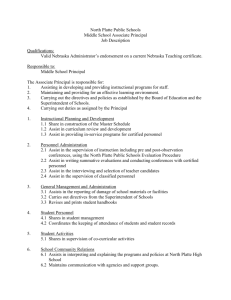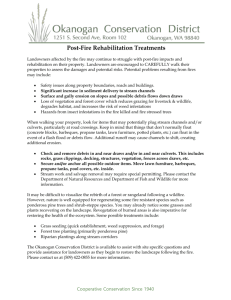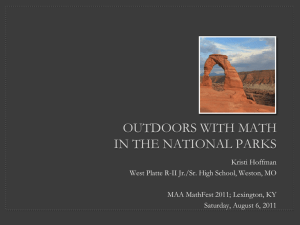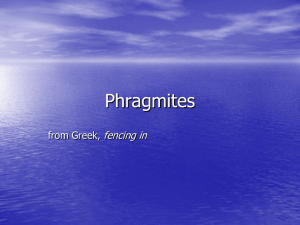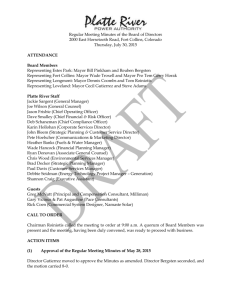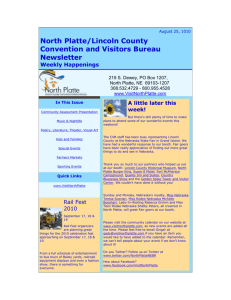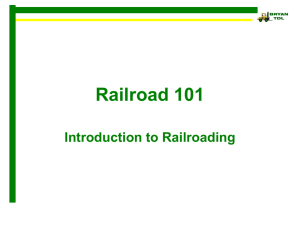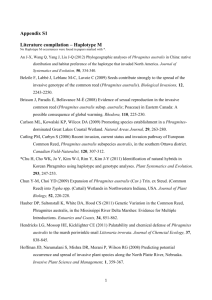2008-2013Summary_compressed_Final
advertisement
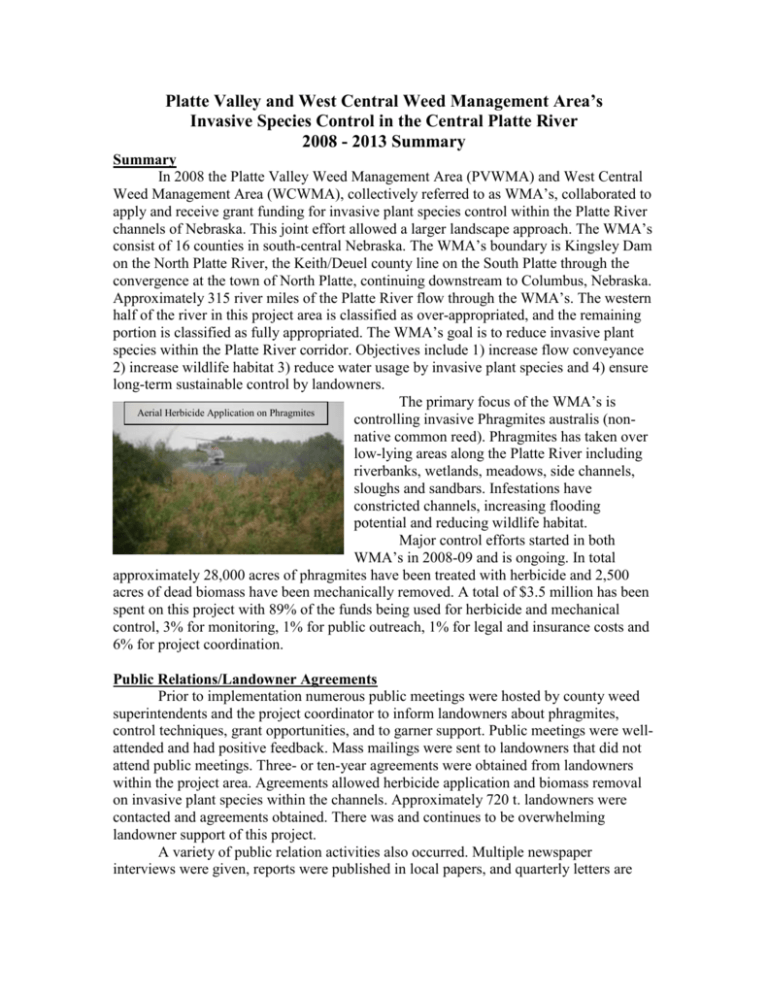
Platte Valley and West Central Weed Management Area’s Invasive Species Control in the Central Platte River 2008 - 2013 Summary Summary In 2008 the Platte Valley Weed Management Area (PVWMA) and West Central Weed Management Area (WCWMA), collectively referred to as WMA’s, collaborated to apply and receive grant funding for invasive plant species control within the Platte River channels of Nebraska. This joint effort allowed a larger landscape approach. The WMA’s consist of 16 counties in south-central Nebraska. The WMA’s boundary is Kingsley Dam on the North Platte River, the Keith/Deuel county line on the South Platte through the convergence at the town of North Platte, continuing downstream to Columbus, Nebraska. Approximately 315 river miles of the Platte River flow through the WMA’s. The western half of the river in this project area is classified as over-appropriated, and the remaining portion is classified as fully appropriated. The WMA’s goal is to reduce invasive plant species within the Platte River corridor. Objectives include 1) increase flow conveyance 2) increase wildlife habitat 3) reduce water usage by invasive plant species and 4) ensure long-term sustainable control by landowners. The primary focus of the WMA’s is Aerial Herbicide Application on Phragmites controlling invasive Phragmites australis (nonnative common reed). Phragmites has taken over low-lying areas along the Platte River including riverbanks, wetlands, meadows, side channels, sloughs and sandbars. Infestations have constricted channels, increasing flooding potential and reducing wildlife habitat. Major control efforts started in both WMA’s in 2008-09 and is ongoing. In total approximately 28,000 acres of phragmites have been treated with herbicide and 2,500 acres of dead biomass have been mechanically removed. A total of $3.5 million has been spent on this project with 89% of the funds being used for herbicide and mechanical control, 3% for monitoring, 1% for public outreach, 1% for legal and insurance costs and 6% for project coordination. Public Relations/Landowner Agreements Prior to implementation numerous public meetings were hosted by county weed superintendents and the project coordinator to inform landowners about phragmites, control techniques, grant opportunities, and to garner support. Public meetings were wellattended and had positive feedback. Mass mailings were sent to landowners that did not attend public meetings. Three- or ten-year agreements were obtained from landowners within the project area. Agreements allowed herbicide application and biomass removal on invasive plant species within the channels. Approximately 720 t. landowners were contacted and agreements obtained. There was and continues to be overwhelming landowner support of this project. A variety of public relation activities also occurred. Multiple newspaper interviews were given, reports were published in local papers, and quarterly letters are sent to landowners informing them of the progress made and keeping them update on future plans. Control Implementation Arial and ground application techniques were used to apply herbicide while disking and shredding were used for biomass removal. Bid packages were sent to all contractors that showed interest in the project. Contractors were selected on price, quality of previous work, references and time frame available. To date, the majority of applications have been performed by helicopter and the biomass removal has been both by disking and shredding. High river flows in 2010 prevented partial biomass removal from occurring but flows snapped two-year dead phragmites stems and removed the majority of standing dead biomass. Infestations within and along Platte River channels were paid in full by partnering agencies. A cost share policy was established for landowners with infestations outside of channel high banks Initial evaluation of control has been very positive. Herbicide application has proved effective with minimal re-infestations occurring. Flow conveyance has improved within the central Platte River as a result of this project and wildlife habitat has increased. Initial Phragmites Infestation After Herbicide Application Current View of Channel Monitoring Yearly helicopter flights are flown along river channels from Columbus, Nebraska to Ogallala, Nebraska to evaluate control measures and to document reinfestations and/or missed infestations. A photo-point monitoring plan was implemented using a GPS-enabled digital camera and voice GPS documenting system. Monitoring data is used to document success of treatments and for guiding future control. Detailed maps showing invasive plant infestations remaining, including the approximate acres have been produced and continually updated. Yearly monitoring is planned into the future to document long-term success of the project. In 2010, WMA’s implemented a monitoring program designed to detect phragmites infestations outside of Platte River channels. Color infrared imagery and GIS is being used to detect infestations. County maps are produced and given to county weed districts to implement control measures. These outside infestations are considered seed sources and if not controlled have the ability to re-infest the channels of the Platte River. In 2008, PVWMA implemented a quantified research design to develop best management practices for controlling phragmites. A second long term control research project was completed with the University of Nebraska-Lincoln. Results from both projects are being used in guiding management decisions. A pilot water quality test was done during late September 2009. Eleven water samples were collected at four locations. In samples, Imazapyr was found to be far below FIFRA’s LD50 of invertebrates’ dosage which is greater than 100,000 ppb. The highest amount detected was 53 ppb in a slow moving backwater slough area that was surrounded by phragmites and received direct application. A complete water quality summary can be found at www.plattevalleywma.org. Future Goals The WMA’s have accomplished the initial control and are now focusing on monitoring and sustaining control within river channels. Yearly monitoring flights will supply needed information on any remaining infestations and help detect re-infestations at an early stage. Control techniques will occur on any detected infestations with in channels of the Platte River. Infestations outside of river channels will be detected by aerial flights and county wide CIR imagery analysis. County weed districts will help implement cost share policy and ensure control measures. Public outreach is an ongoing endeavor. Mass mailings and public meetings are the primary communication strategy. A best management guide Overall goal – braided river channel free of was published and sent, free of charge, to all riparian invasive vegetation with moving sandbars landowners in 2013. It is also available for downloading at www.plattevalleywma.org. Public media events will be attended as desired to promote WMA’s. Newspaper and TV interviews will be given as needed. Funding The WMA’s continue to seek funding from state and federal grants and ways to partner with local stakeholders to enhance their efforts. Current funding sources include: Nebraska Environmental Trust Fund, Platte River Recovery and Implementation Program, Nebraska Department Agriculture, Central Platte NRD and Tri-Basin NRD. Table 1. Summary by Expense Category (2007- June 2011) Herbicide application Monitoring Public Legal and Coordinator Totals and removal Outreach Insurance salary* $3,167,653.78 $104,558.92 $42,636.94 $30,743.60 $196,481.99 $3,542,075.23 89.4% 2.9% 1.3% 0.9% 5.5% 100% *Includes salary, benefits, indirect costs and mileage expense, two coordinators in 2008
